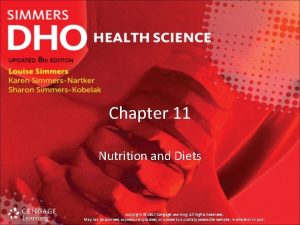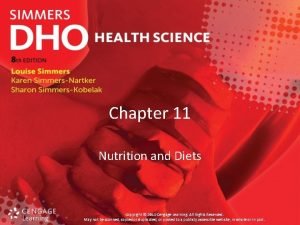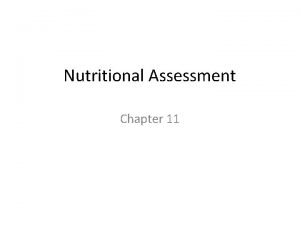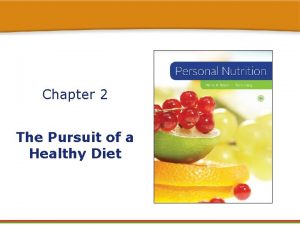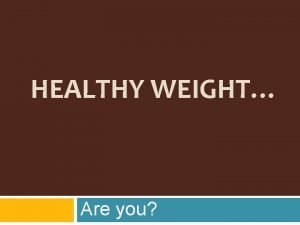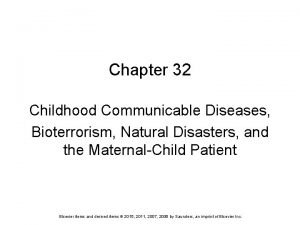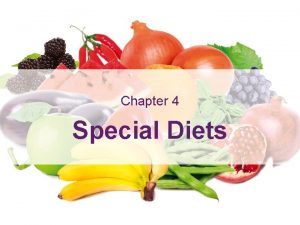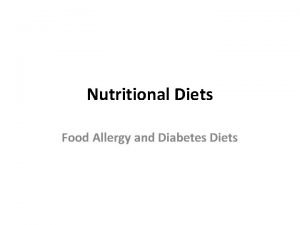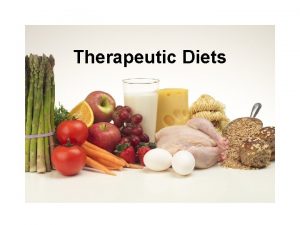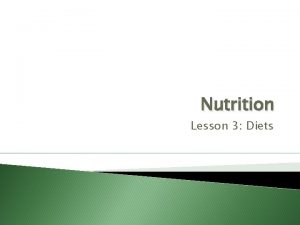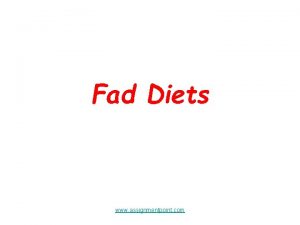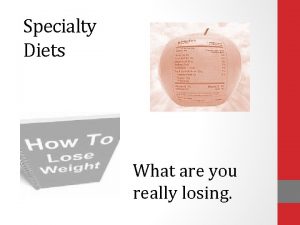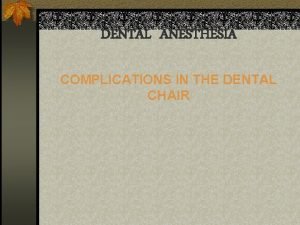Chapter 06 Special Diets Dental Diseases Dental Diseases










- Slides: 10

Chapter 06: Special Diets – Dental Diseases

Dental Diseases The two main forms of dental disease are: 1. Dental caries is the decay of the enamel of teeth, leading to tooth decay. 2. Periodontal disease affects the gums and tissues surrounding the teeth.

Plaque • Plaque is the main cause of dental disease. • Plaque consists of bacteria and acid, which is formed by the breakdown of food, especially sugar, in the mouth. • If plaque is not removed, it gradually breaks through the enamel on the tooth and can eventually cause cavities. • Bacteria can then enter the exposed softer dentine and pulp cavity, causing toothache.

Tartar • Plaque can harden on teeth at the gum line and between teeth and may not be removed by normal brushing. • This plaque build-up (tartar) causes irritation and inflammation of the gums leading to periodontal disease. • If the gums become infected, an abscess may occur – this is a painful swelling that contains pus.

Guidelines to Prevent Cavities and Gum Disease • Avoid sugar • Sealant may be applied to the biting surface of the molars in childhood (on permanent teeth) to prevent the onset of dental caries (decay). • Increase the resistance of the tooth by brushing at least twice a day. • Remove bacteria by using a mouthwash.

Guidelines to Prevent Cavities and Gum Disease (continued) • • Floss regularly to remove lodged food from between teeth. Visit a dentist at least twice a year. Use artificial sweeteners instead of sugar. Drink fluoridated water instead of fizzy drinks.

Low-Sugar Diet • Sugar is a source of energy in the diet, but has no other nutrients, so it is filled with ‘empty kilocalories’. • Many people have a ‘sweet tooth’. Food manufacturers add sugar to many foods to encourage people to eat them – it is even found in savoury foods. • Sugar is the main cause of tooth decay as it produces the most acid in the mouth. The more often sugar is eaten, the more acid that attacks the teeth, increasing the risk of decay. • Health problems associated with a high-sugar diet include diabetes, tooth decay, malnutrition and weight problems, including obesity.

Sugar: Label Check • Find out the sugar content of a variety of foods – both sweet and savoury – by looking at your food labels. • Remember to check for hidden sugar (glucose, fructose, sucrose and honey are all forms of sugar). • Which foods are high in sugar? • List as many high-sugar foods as you can.

Guidelines for Reducing Sugar • Avoid sugar-rich foods (junk foods) like fizzy drinks, sweet snacks, drinks sweetened with sugar, sugary breakfast cereals, cakes, biscuits and high-sugar convenience foods. • Reduce the amount of sugar added during food preparation and cooking. • Use artificial sweeteners instead of sugar to sweeten foods. • Eat healthier, low-sugar snacks.

Dental Diseases: Quick Revision 1. Can you describe two problems associated with a high-sugar diet? 2. Can you name three ways of reducing sugar in the diet?
 Test chapter 11 nutrition and diets
Test chapter 11 nutrition and diets Test chapter 11 nutrition and diets
Test chapter 11 nutrition and diets Chapter 11 nutrition and diets
Chapter 11 nutrition and diets Optimal nutritional status
Optimal nutritional status Diets based on only one basic food element
Diets based on only one basic food element Most fad diets do follow the mypyramid guidelines.
Most fad diets do follow the mypyramid guidelines. Fad diets def
Fad diets def Chapter 24 lesson 1 sexually transmitted diseases
Chapter 24 lesson 1 sexually transmitted diseases Chapter 8 skin disorders and diseases review questions
Chapter 8 skin disorders and diseases review questions Chapter 6 musculoskeletal system diseases and disorders
Chapter 6 musculoskeletal system diseases and disorders Chapter 32 childhood communicable diseases bioterrorism
Chapter 32 childhood communicable diseases bioterrorism
